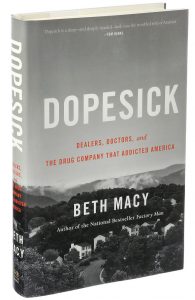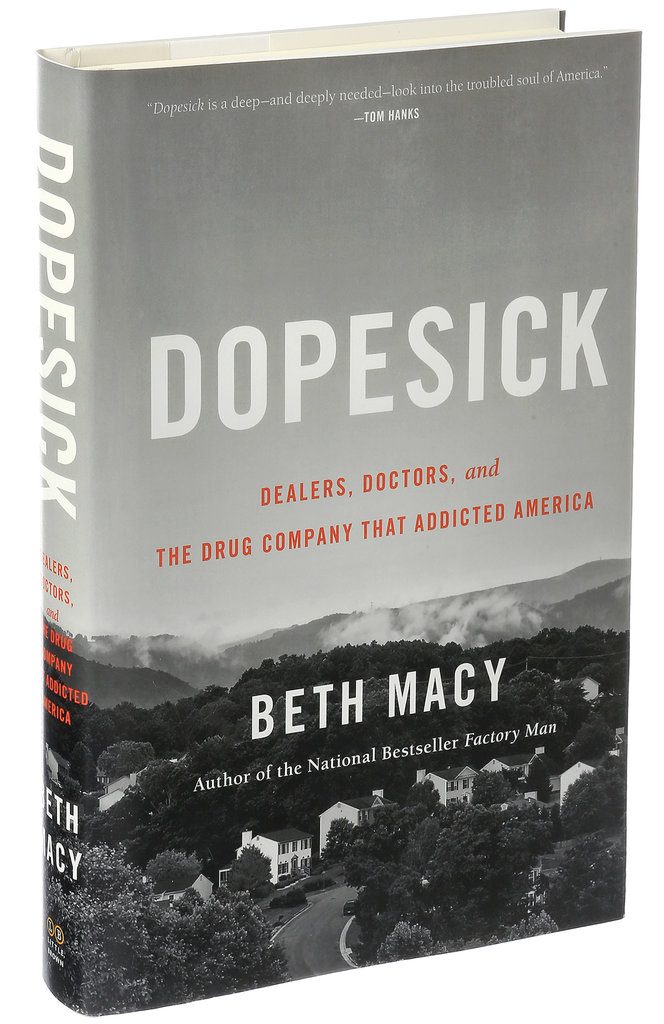
Dopesick: Dealers, Doctors, and the Drug Company That Addicted America
Beth Macy
New York: Little, Brown, 2018
Review by Elizabeth Felicetti
As a priest, I’ve had the privilege of being present at numerous deaths. If I had attended the end of my father’s life as a pastor instead of a daughter, I may have considered it a “good death”: he was surrounded by his wife, all four children, four grandchildren. As his daughter, however, even though he died while I held his hand—something for which I had hoped—his death was the worst I’ve witnessed. Being present as a daughter instead of a priest colors the experience, but much of my horror was due to sitting with him for eight hours before his death as hospice struggled to get his pain under control. After cancer treatment thirteen years before destroyed his internal organs and led to too many surgeries to count, he had been on three different opioids for eleven years, including OxyContin and fentanyl. His tolerance to opioid pain medication made his suffering nearly unendurable to watch. Four years later, I remain haunted by the only word he spoke that day, “bowl,” when he thought he was going to be sick.
Dopesick: Dealers, Doctors, and the Drug Company That Addicted America takes its title from the sickness that afflicts addicts suffering withdrawal. One addict explained to author Beth Macy, a Roanoke journalist who began reporting on the heroin epidemic in 2012, “At the end of your journey, you’re not going after drugs to get high; you’re going to keep from being sick” (42). Macy weaves in dealers, doctors, and drug companies as the title suggests, but the heart of the story deals with addicts and the people who love them. Due to my father’s long-time dependence on opioids for pain management, I had a hard time delving into the book, but eventually became engrossed as Macy’s writing revealed that she was torn apart by what she encountered in the lives of those afflicted.
Many small-town addicts began with prescription opioid pain medication. Macy asserts, “Purdue handpicked the physicians who were most susceptible to their marketing, using information it bought from a data-mining network…to determine which doctors in which towns prescribed the most competing painkillers” (p. 32). If a patient lost access to prescribed opioids, they often turned to illegal drug dealers and sometimes heroin (60). This spread from small, rural towns and eventually to suburbs. One African-American counselor noted to Macy, “As long as it was in the lower economic classes and marginalized groups…it was OK because it was those people… But the moment it crossed those boundary lines from the inner city into the suburbs, it became an ‘epidemic’… It’s a monster now, but nobody paid any attention to it until their cars were getting robbed, and their kids were stealing their credit cards” (130). Macy writes, “The real perfect storm fueling the opioid epidemic has been the collapse of work, followed by the rise in disability and its parallel, pernicious twin: the flood of painkillers pushed by rapacious pharma companies and regulators who approved one opioid pill after another” (151).
Proponents of twelve-step recovery programs committed to abstinence will take issue with parts of the book, but Macy is effective in her argument that maintenance treatment works better than abstinence rehabilitation for opioid recovery, citing the National Institute on Drug Abuse, the Institute of Medicine, and the World Health Organization, as well as subjects interviewed. Macy quotes Tracey Helton Mitchell, recovering heroin user and activist: “‘In the United States, we are very attached to our twelve-step rehabs, which are not affordable, not standardized from one place to another, and not necessarily effective’ for the opioid user” (174) while federal prosecutor Andrew Bassford tells Macy, “Rehab is a lie. A multi-billion dollar lie” (251).
Dopesick disturbs, as it should. As the daughter of a long-time opioid user, this opinion by Federal Judge James Jones lingers: “Does the relief afforded by high-dosage opioids to those with severe, life-altering pain outweigh the risks of harm from addition?” (78)
The Rev. Elizabeth Felicetti, rector of St. David’s Episcopal Church in Richmond, Virginia, pursues an MFA at Spalding University. Her essays, book reviews, and poetry have appeared in numerous publications, and some critical essays are forthcoming in the lectionary commentary series Connections by Westminster John Knox Press. She tweets @bizfel.

